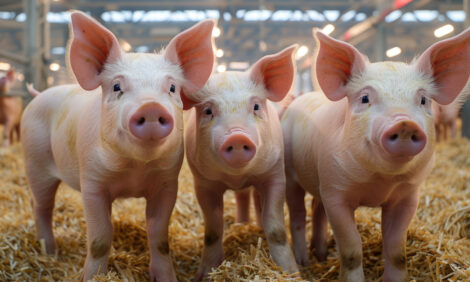



Pork Outlook Report - September 2003
By U.S.D.A., Economic Research Service - This article is an extract from the September 2003: Livestock, Dairy and Poultry Outlook Report, highlighting Global Pork Industry data. The report indicates that U.S. imports of canadian slaughter hogs are up sharply.| Overview |

Large hog exports by Canada have altered U.S. pork production and trade expectations for the balance of 2003 and the first half of 2004. Larger U.S. imports of Canadian slaughter hogs is the key factor pushing expected 2003 hog slaughter to nearly 99.3 million head, and pork production to 19.6 billion pounds.
Higher slaughter hog imports will likely persist into 2004, lifting estimated slaughter for next year to 98.4 million head, and estimated production to 19.5 billion pounds.
| 2003 Pork Production Pulls Almost Even with 2002 |
Responses to the BSE situation in Canada by the U.S. and Canadian markets have altered expectations for U.S. pork production and trade for the balance of 2003 and the first half of 2004. Larger U.S. imports of Canadian slaughter hogs is the key factor pushing expected 2003 hog slaughter to 99.3 million head, and pork production to 19.6 billion pounds. Higher than average slaughter hog imports will likely persist through the first half of 2004, lifting estimated slaughter for next year to 98.4 million head, and estimated production to 19.5 billion pounds.
These upward adjustments in estimated slaughter and production leave very little daylight between 2002 slaughter and production, and estimates for this year, and 2004. Only 1 percent fewer hogs are expected to be slaughtered this year than in 2002. Production will likely be off by less than 0.5 percent if heavier year-over-year dressed weights continue for the rest of this year. Hog slaughter and pork production in 2004 are each expected to be less than 1 percent lower than 2003. Thus, breeding herd reductions of 2002 have largely been offset by larger hog and feeder pig imports from Canada, higher dressed weights, and small productivity increases.
| Hog Prices Weaker, Retail Prices Steady |
|
Retail Pork Price
Percent change from previous month 
|
Record high prices in the beef sector finally spilled over into the pork sector last week. Although the Estimated Composite Pork Carcass Cutout averaged $64.21 from June through August, it had declined into the high $50 range in late August, and into early September.
For the week ending September 13 the Cutout added more than $5 to the previous weeks close however, on the strength of higher wholesale demand for loins, butts, hams, and bellies. Retail pork prices appear to be on the increase as well.
USDA reported an August composite retail pork price of $2.71, in increase of almost 2 percent from July. Higher beef prices and declining supplies of market ready cattle will likely provide continued support for both wholesale and retail pork prices well into the Spring of 2004.
Adequate supplies of export-ready Canadian pork products as well as slaughter animals could
moderate pork price increases.
| U.S. Imports of Canadian Slaughter Hogs Up Sharply |
|
Weekly Hog Slaughter
Percent change from last year 
|
U.S. imports of Canadian slaughter hogs have increased sharply since June. Live hog imports
reported by USDA/APHIS indicate that U.S. imports of barrows and gilts for the period June-
August 2003 increased 48 percent over the same period of 2002. Larger imports of Canadian
slaughter animals is consistent with Canadian slaughter data, which indicate that Federal
Slaughter for June-August is more than 7 percent lower than in the same period of 2002. The
Canadian data further suggest that slaughter facilities in the western provinces have reduced
slaughter numbers the most. For June-August 2003, Manitoba’s slaughter is more than 19 percent
lower than last year, and Saskatchewan’s slaughter was 11 percent lower than last year.
| Pork Consumption Lower in Canada in Response to BSE Situation |
An important reason for lower Canadian slaughter - and thus a greater supply of exportable hog - could be weak demand for pork by Canadian consumers, since the onset of the BSE situation in late May. It appears that Canadian consumers have increased their consumption of domestic beef as a sympathetic response to the plight of the Canadian beef industry. Lower Canadian pork prices contributed to lower packer margins and subsequent cutbacks in Canadian slaughter, diverting hogs to the United States for slaughter. Larger imports of Canadian slaughter hogs will likely persist, until supply and demand balance has been achieved in Canada, and more normal pork consumption rates resume.
| Fallout From Canadian BSE Situation Extends to U.S. Pork Product Imports |
Weak consumer demand for pork products in Canada appears to have created attractively priced products for U.S. importers. Despite the lower valued U.S. dollar, June and July imports of Canadian pork products increased 14 percent over the same 2 month period last year. For the first 7 months of 2003, imports of Canadian pork products increased 16 percent over 2002.
Links
For more information view the full Livestock, Dairy and Poultry Outlook - September 2003 (pdf)Source: Livestock, Dairy and Poultry Outlook - U.S. Department of Agriculture, Economic Research Service - September, 2003








